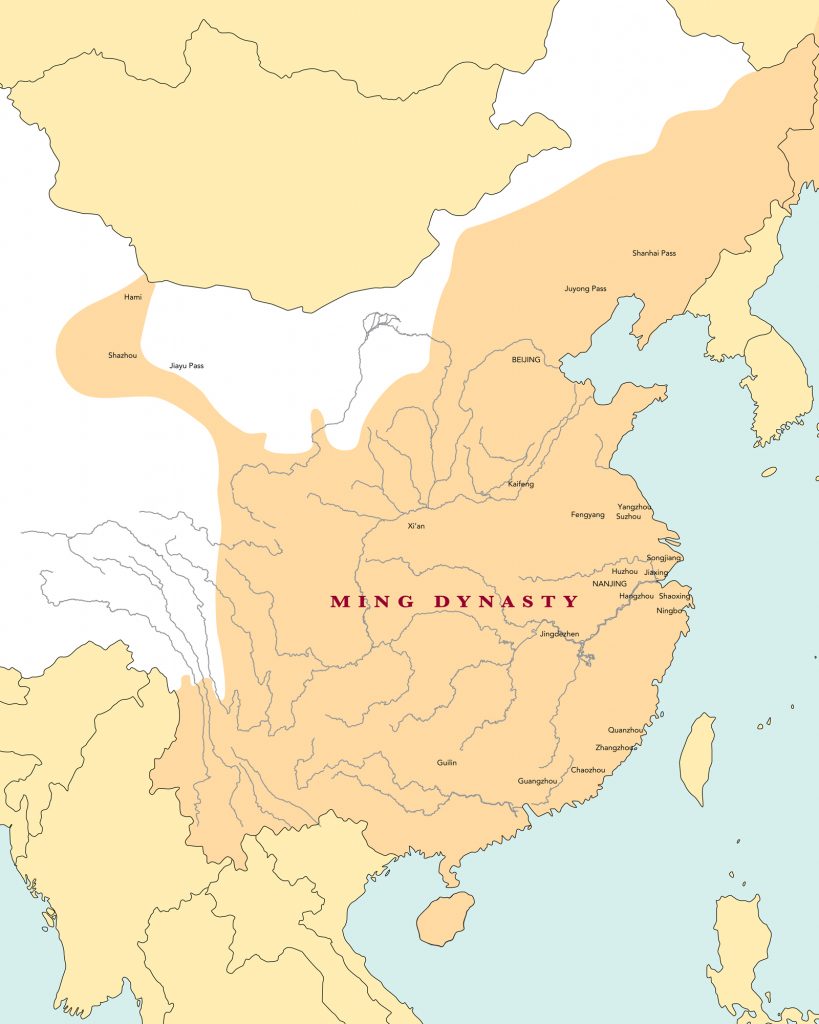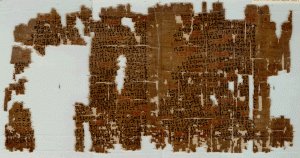The Ming dynasty was founded by Zhu Yuanzhan and spanned nearly 300 years, from the collapse of Yuan Dynasty in 1368 to the dominance of the Manchus in 1644. It encompassed the reign of sixteen emperors and was one of the longest, most stable ruling periods in Chinese history. The dynasty marks a period of Chinese cultural restoration and became known as the “Empire of the Great Ming.” Being the last dynasty to be ruled by true Hans, or ethnic Chinese, it has been called one of the greatest times in human history for government order and social stability. While the dynasty’s reforms made great contributions to the country’s economy and architecture, it struggled with trade operations and its military lacked the ability to protect such a great empire.
The Ming Dynasty was a time in which China experienced economic and population growth. During the Ming period, the Chinese comprised between one-quarter and one-third of the world’s population. The population growth was fueled by several combined factors. First, the Ming government secured extended periods of peace times that aided population growth. Second, China was fortunate not to suffer any nationwide epidemics. Last, China’s geographic layout provided its people with a safeguard against natural disasters, warfare, and social unrest.1

The dynasty established an advanced economy for its time. Trade developed further with the establishment of Beijing and the construction of a canal system. The Grand Canal was renovated between 1411 and 1415, during the Ming Dynasty. The reopening of the canal allowed China to undergo a major commercial revolution, and it served as the economic lifeline for domestic trade within China. Cotton rose as a major commercial crop in China. Produced mainly in the Yangzi River Valley, the Grand Canal was used to keep up with the large demand of both raw and spun cotton. Concurrently, luxury goods such as silk and porcelain were flourishing, and the canal was used to transport these goods to Beijing.2
Industry during the Ming Dynasty also thrived. By 1500, the Chinese were producing large amounts of consumer goods. Chinese goods such as porcelain, lacquerware, and silk found their way to major cities around the world. Well-known Chinese wares, characterized by their cobalt-blue painted motifs, were produced during this era. An abundance of paper was also produced, which led to new methods of printing and gave rise to a substantial publishing industry. The Chinese published everything from fine Chinese classics to common handbooks for travel and daily life, to novels filled with fighting and sex.3
The Chinese government had developed a foreign policy known as the tribute system to help them negotiate with the outside world, and the Ming Dynasty promoted it early on. Under this system, the Chinese treated their neighboring lands as tributary states. The tributary state agreed to take on the status of vassal to the Chinese and were required to exchange gifts, monitor foreign trade, and handle diplomatic relations. The tribute required from the tributary state was not enormous and they could remain independent of China. The tributary states would send goods to China with their diplomatic missions and then they would also receive gifts from the emperor. This helped maintain peaceful bonds and stability among the states and China while increasing trade. The tributary states would benefit from this system because they could obtain the goods they wanted from China without having to go to war. The system also sponsored a series of seven great maritime expeditions, from 1405 to 1433, led by Zheng He. He used these expeditions to invite states to join the tributary trade and prohibit private citizens from participating in maritime trade. After 1433, the Ming government ended these expeditions as they believed they had what they needed domestically. With the end of the expeditions, China turned inward, reduced it contacts with the world beyond its borders, and caused many of their merchants to turn to smuggling to survive.4
The Ming Dynasty’s military system was created during the rule of Emperor Hongwu and lasted until the end of the Ming Dynasty. The army was commanded by a hereditary officer class. Members of the military and their income was to be provided by their families. Each family was to provide for ten soldiers, of which three were assigned to military tasks and seven to farming the land of the military colonies.5
The dynasty attempted to create a strong military by utilizing elements of the Yuan system with others and creating a system called the weisuo system. The system utilized military garrison units to maintain peace. The system consisted of a guard unit of 5600 men known as a wei. Each wei was then divided into five qianhu suo consisting of 1,120 men in each. The qianhu suo was then divided into ten units called baihu suo of 112 men each. Each garrison unit was allotted a tract of military-owned land that they were required to work on to provide their own food. This system was designed to reduce the cost to the public and to make the military more efficient. Military soldiers were usually of low social status and desertion became a serious problem. Additionally, because the military was running under hereditary practices, it was difficult for the government to replace deserters in addition to battlefield casualties. In addition to the problem of desertion, the other major issue with the weisuo system was that many of the garrison units were unable to produce enough food supply in order to feed themselves.6
The Ming Dynasty’s military was also limited by its centralized planning approach. When preparing for certain campaigns, the entire military would be reequipped and retrained for the mission. Doing this caused a number of bureaucratic issues, ultimately making the military slow to respond to threats. Their cavalry was also not heavily equipped when their equipment was replenished. Troops were frequently used for non-military purposes, which significantly reduced the number of battle-ready troops.
The Ming Dynasty was one of the most successful eras in Chinese history. At its peak, it made China a global powerhouse by influencing the world with its social and economic stability. However, their greatness was marred by a weak, poorly trained military that lacked in abilities, equipment, and planning. Their inefficient military and restrictions on maritime trade created huge hardships during this brilliant era in Chinese history.
- Berkshire Encyclopedia of China: Modern and Historic Views of the World’s Newest and Oldest Global Power, 2009, s.v. “Grand Canal,” by Andrew Field. ↵
- John E. Wills, “Empire, Ming” History of World Trade Since 1450, vol. 1 (2006): 234-237. ↵
- Berkshire Encyclopedia of China: Modern and Historic Views of the World’s Newest and Oldest Global Power, 2009, s.v. “Porcelain” by Ooi Giok Ling. ↵
- Guangqiu Xu, “Ming Dynasty (1368-1644): Foreign Trade,” in World Eras, vol. 7 (2003): 204-205. ↵
- Guangqiu Xu, “Ming Military Expansion and Political Reforms,” in World Eras, vol. 7 (2003): 259-261. ↵
- Guangqiu Xu, “The Military Organization,” in World Eras, vol. 7 (2003): 253-255. ↵



21 comments
Barbara Ortiz
Great article Aaron. I enjoyed reading more about the Ming dynasty then what is covered in the textbook. I find it interesting that one of the most successful and enlightened dynasties would allow itself to fall behind. At their height, it had a great expeditionary force. However, they ended these and did not properly care and administer to their military, allowing for an open door for the Manchus to come in and take over.
Aaron Sandoval
I really enjoyed reading this article, I had very little prior knowledge of this topic, and after reading this article I walked away knowing more about the Ming Dynasty. The author did a great job of giving an overview of the origin of the Ming Dynasty as well as how successful it was. The author did a great job of detailing the amount of land that was owned, the strict rulers, the population, and the wealth of resources.
Paula Salinas Gonzalez
Very well written article! I didn’t really know anything about the Ming Dynasty until now. It’s impressive how much the dynasty was able to do for China and how much it revolutionized it. I really liked how you explained how the dynasty helped China grow and wonder how different history would be if they would’ve had a stronger military.
Emmanuel Ewuzie
Strong governments have been the key to the most successful empires in history. Personally, my favorite empire/dynasty is the Mongols. They were some beasts the way they conquered everything and everyone. A polar opposite to the Ming Dynasty in terms of military strength. The Mongols were ruthless and renowned for their military strength and strategies.
RL
I wouldn’t go as far to say their military was weak throughout the dynasty. There were certainly debacles and failures, the grandest of which was the Tumu crisis in which a Ming emperor was captured and his army decimated. But there were bright spots during the Ming in which their military was quite formidable. Such as the early years under generals Xu Da and Chang Yuchun, they pursued the Mongols across the steppes and won notable victories. Ming sent a expedition to Korea and contributed to fighting off Hideoyoshi’s 2 invasions, and surprisingly they even won a few scattered naval engagements with the Portuguese off the coast of Canton in the 1500’s as well. I think it’s more accurate to say the Ming’s military record was mixed.
Christopher Hohman
Nice article. Ming dynasty china was an impressive state. It is no wonder that the Europeans sought trade routes to the east indies. The wealth of this great nation and all the goods they produced were so alluring that the Europeans wanted them so much. It is unfortunate that their military was not strong enough to hold together the empire. Maybe if they had come up with a better system to manage their military they would have been militarily stronger.
Jocelyn Moreno
This article was very descriptive, I felt like I learned more about the Ming Dynasty more than I did in my high school class! I find it fascinating how they were so involved in business relations internationally and regionally. Many dynasties from what I recall did not like to bargain with others. It’s nice to see the Ming Dynasty flourish into a successful and one of the most powerful dynasties of their era.
Tyler Sleeter
Really informative article. I was not aware of the economic aspects of the Ming Dynasty until reading this article and I found it really interesting. I knew that China was famous for it’s silk and Ming era pottery, but I had not heard about the cotton and paper industry that was also common at this time. I found it interesting that they published so many books at that time meaning that many people must have been literate. It struck me as odd that the government ended expeditions when they believed the country was able to produce everything they needed domestically and trade was no longer essential. I had always known that China mostly practiced isolationism, but did not realize it went back to the time of the Ming Dynasty.
Mario Sosa
Very good description of the strengths and weaknesses of the Ming dynasty! You would think that with such an excellent economy, the Ming dynasty would have managed their military a lot better. Just imagine today’s world if the Ming dynasty had kept on expanding outwards (Maybe even perhaps all the way to the Americas?) In any case, fantastic job on the article; nicely done!
Justin Garcia
This was a very informative article. The Ming Dynasty truly was one of the most successful dynasty. It not only had a well regarded economy but also a well respected ruler. It is however ironic that because they were successful in other instances they lacked an essential feature. They lacked a strong military and by that fact, this successful dynasty would meet it’s end. Overall this is a great article.